| Home>Myth>Article |
The Legend of Isotake
The following text is a slightly modified machine translation and may have some unnatural parts.
==Shinjo beach==
It is said that Susanoo came and landed on the beach of Shinjo (The beach where God landed) in Isotake town, Oda City, Shimane Prefecture. Susanoo was accompanied by his son, IsoTakeru, and his daughters, Oyatsuhime and Tsumatsuhime.
The rocks of Kamishima (Island of god) are said to be the place where Susanoo stayed at the ship and observed the opposite bank when he landed.

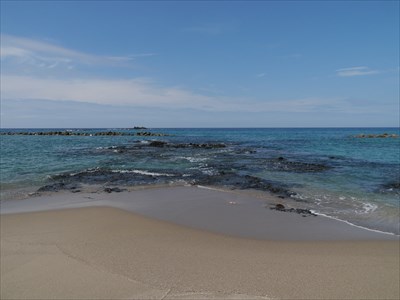
Shinjo Beach at Isotake town
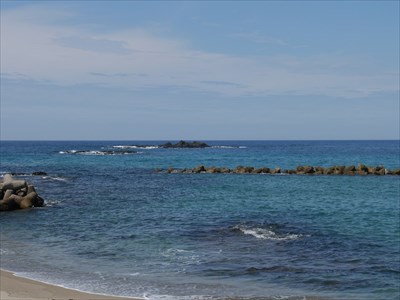

Kamishima Rock
IsoTakeru is a god with the name of "Takeru (ferocious)" and gives a rough impression. However, according to one book of the Nihon Shoki, IsoTakeru who landed in Japan planted trees in various parts of Japan and made it a lush land. In that respect, there is an image of a gentle god. He is equated with Oyabiko, who appears in Kojiki.
==KarakamiShiragi Shrine==
KarakamiShiragi Shrine is located on the west side of the cove where the Oura fishing port in Isotake town, Oda City is located. Contrary to the legend that Susanoo came from Silla, one book of the Nihon Shoki also records the myth of creating a tree to make a boat going from Japan to Silla.
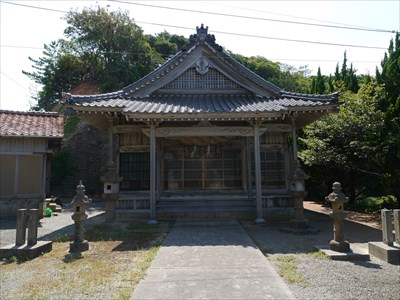
KaraKamiShiragi Shrine
Karakami means a foreign god. Shiragi means ancient Silla.
According to the shrine's biography, Susanoo went to Silla with IsoTakeru, Oyatsuhime, and Tsutsuhime. From there he landed on Kamishima (Island of god) Rock near the Oura coast when he returned to Japan on a clay boat. Furthermore, only Susanoo built a shrine here and stayed there. Later, it is said that the two goddesses were also enshrined.
In the Oura area, where the Oura coast is located, there is a traditional New Year's event called "Guro". A large bamboo called Chigi is erected, and a circular temporary house is made around it with trees, bamboo, or straw mat. There is a tradition that if you warm yourself at the fire and bake rice cakes and eat them, you will not get sick and you will get a good catch.
==God farewell slope==
A few hundred meters west of JR Isotake Station, there is a stone monument commemorating the slope of God Farewell (KamiWakareZaka) at the intersection of National Route No. 9 and the old road. There is a legend that his brother IsoTakeru and his younger sisters Oyatsuhime and Tsutsuhime broke up here. According to the Nihon Shoki, IsoTakeru finally entered the country of Ki (now Wakayama Prefecture).
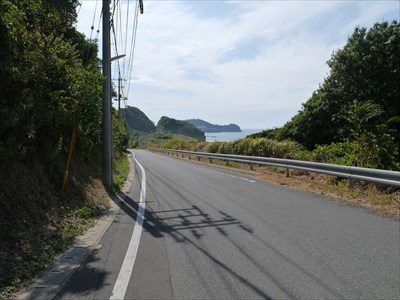
God Farewell Slope
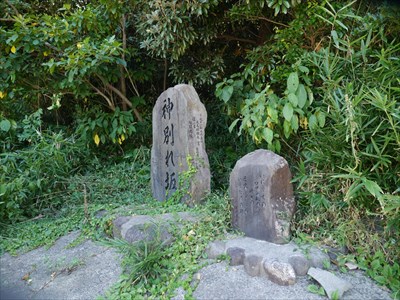
Monument at God Farewell Slope
Oyatsuhime and Tsumatsuhime are considered to be the goddess of trees and forestry. Tsumatsuhime is also known as the goddess of weaving.
It is said that Oyatsuhime and IsoTakeru planted trees in the mountains all over the country at the behest of Susanoo and lived in country of Ki. According to the description of Nihon Shoki, it seems that Oyatsuhime and Tsumatsuhime also entered the country of Ki. In fact, there is Oyatsuhime Shrine in Wakayama City, Wakayama Prefecture.
==Isotake Shrine==
Isotake Shrine is located several hundred meters southeast of JR Isotake Station. Isotake Shrine enshrines IsoTakeru and Emperor Ojin, and also enshrines Oyatsuhime and Tsumatsuhime.
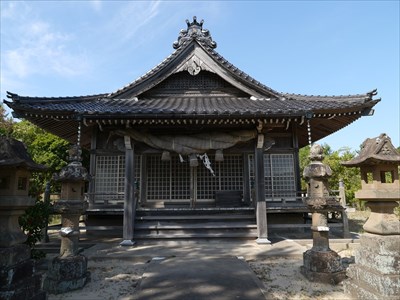
Isotake Shrine
According to "Japanese Gods: Shrines and Sanctuaries, Vol. 7, Sanin," Susanoo, along with IsoTakeru, Oyatsuhime, and Tsumatsuhime, landed on the way back from the Korean Peninsula. IsoTakeru remained here, sown tree seeds and worked for the expansion of production, and was enshrined in Mt. Miyayama of Minato. In addition, Susanoo stayed in Oura and was enshrined at the KarakamiShiragi Shrine. The two goddess, who broke up with Susanoo on the god farewell slope near Minato, spread their businesses such as forestry and weaving, and Oyatsuhime was enshrined at Oyahime-no-Mikoto Shrine in Oya town. And it is said that Tsumatsuhime was enshrined at Karame Shrine, which is a shrine outside the precincts of Monobe Shrine.
Going south on Prefectural Road 289 from Isotake, there was Oyahime-no-Mikoto Shrine in Oya town. It is said that the Karame Shrine, which enshrines Tsumatsuhime, is located outside the precincts of Mononobe Shrine.
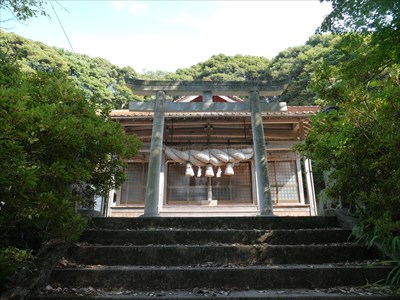
Oyahime-no-Mikoto Shrine
==Digression ==
It's a romantic legend that brother and sister break up. In ancient times, the feelings of the same mother and half-sister may be different.
You can overlook the beach of Shinjo from the eating and drinking corner of the Wada Delicacies (Chinmi) Main Store.
Prefectural road 289 also has a long section of just one lane, and I was nervous about whether an oncoming vehicle would come while driving.
I visited Mononobe Shrine in the summer of 2016, but I didn't know where Karame Shrine was.
==References==
- * 『日本の神々―神社と聖地 第七巻 山陰』(谷川健一/編, 白水社, 1985)pp.170-171